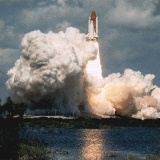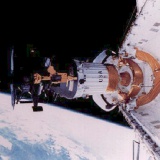| GALILEO MISSION | |
| The Galileo spacecraft was carried into Earth orbit by the Space Shuttle. After leaving the Shuttle's cargo bay, Galileo's engine fired on the 18th October 1989 to take it to Venus. A visit to Venus was not Galileo's primary mission - the visit was in order to obtain a boost by using Venus' gravitational field. | |
 Galileo was taken into Earth orbit by the Space Shuttle Atlantis. |
|
| Galileo spent three years obtaining "gravity assists" from both the Earth and Venus, before heading out to Jupiter. Two years were needed to reach Jupiter. Galileo entered the Jovian system and is now in orbit about Jupiter. The Jupiter mission was originally designed to last two years, but this has been extended. | |
| At present, the Galileo spacecraft is still operating and returning data and images from Jupiter. | |
 The Galileo spacecraft seen here leaving the Space Shuttle's cargo bay. |
|
| The gravity assists given to Galileo, obtained by swinging by Venus and the Earth, also enabled Galileo to make scientific measurements of Venus, Earth, and the Moon. During its long journey to Jupiter, Galileo performed flybys of two asteroids, Ida and Gaspra, thereby becoming the first spacecraft to visit an asteroid. Galileo was also the first spacecraft to discover an asteroidal moon, Dactyl. | |
| The spacecraft is named after Gaileo Galilei, the Italian astronomer who discovered the large moons of Jupiter in 1610. The moons, Io, Ganymede, Callisto, and Europa are also known as the Galilean moons. Part of the mission involved Galileo dropping a probe into Jupiter's atmosphere. The probe, carrying six scientific instruments, descended successfully into Jupiter's atmosphere, making measurements and reporting back to the Galileo Orbiter, until severe pressure destroyed the probe. A very small part of Jupiter's atmosphere now consists of probe material | |
| Once at Jupiter, Galileo's orbit allowed it to make close approaches to Io, Ganymede, Europa, and Callisto, obtaining images of the surfaces of the moons at resolutions never before achieved. The resolution of Galileo images is far superior to those obtained by the Voyager spacecraft. Galileo has also provided imagery of Jupiter's ring system and has confirmed their nature and mechanism of formation. During a close approach to a moon, the spacecraft acquires images and other data which are stored on a tape recorder. When the spacecraft's orbit has taken it too far from the moons to make useful observations, the tape is rewound and the images and data transmitted to Earth. | |
| Galileo also managed to observe the impact of comet Shoemaker-Levy 9 with Jupiter. As Galileo was at the time on the far side of Jupiter, the spacecraft was the only instrument that acquired images of the actual impact. All other observers, using ground-based telescope facilities, had to wait for Jupiter's rotation to carry the impact site into view. | |
| The mission has not been perfect, though. A failure of part of Galileo's communications system has impaired the transmission of imagery. Nevertheless, the high resolution Galileo images of the moons of Jupiter are the best available. Galileo images of Jupiter, its moons and rings, Ida, Gaspra, Venus and the Earth are used in this product. | |
|
|
|